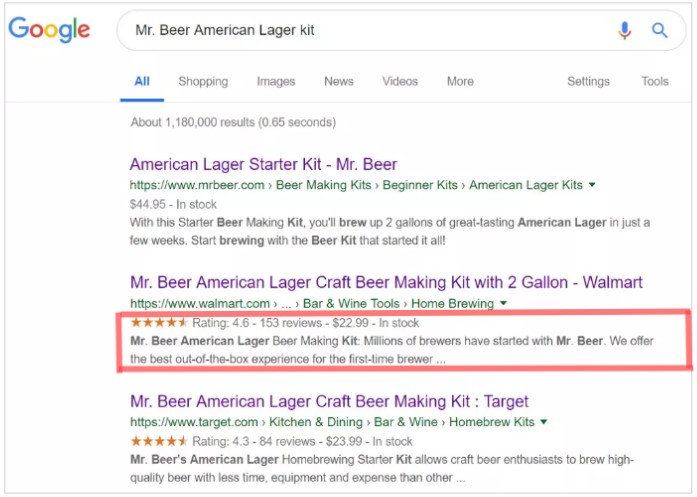Introduction
Over the years, the way people search and shop online has changed significantly. As a result, search engines like Google also changed how products appear in search results, ditching basic listings for rich snippets and product cards. It has become easier than ever for shoppers to find what they need. But this means their old SEO strategies might still need to cut it for businesses. They must evolve their eCommerce SEO strategy to dominate search rankings and reach potential buyers.
But how?
This blog holds the answer to that. But before we share effective ways to revamp the SEO approach for eCommerce stores, let’s understand the major changes Google has made in its product search appearance and why they are important to consider.
Major shifts were witnessed in product search results on Google SERP
Throughout 2023, Google changed how product listings appear in search results.
The key updates include:
- More preference is given to in-depth customer reviews that provide first-hand experience of a product or a service over standard third-party reviews.
- In SERP, product results take up a substantial space (around 45%)
- Organic product results appear in two ways: Merchant listings and Product snippets, providing separate and detailed data reports for both in Google Search Console.
But the question is, why is Google continuously changing its search results appearance for product listings?
One reason is to align better with users’ search intent and provide them with a more streamlined and seamless product shopping experience.
But that’s not all. By offering a more comprehensive shopping experience within search, Google is trying to compete with eCommerce giants like Amazon.
At the same time, prioritizing product results over organic listings makes Google different from other search engines, like Yahoo and Bing.
How can you change your eCommerce SEO strategy to adapt for Google SERP?
These recent shifts in product search appearance on Google SERP allow businesses to showcase their offerings to more potential shoppers.
But that is only possible by making the required changes in your eCommerce SEO approach for Google SERP.
Here are some practical ways to do it:
1. Understand the search intent when doing keyword research
Using advanced semantic search algorithms, NLP technology, and entity recognition, search engines like Google try to understand users’ context and show relevant results.
That is why it becomes crucial for eCommerce businesses to understand the search intent behind each query and target relevant keywords in their product pages or other content.
How to understand the search intent behind keywords?
You can think from the users’ perspective. For example, if a user has to buy a blue denim shirt online, what are the possible queries they can enter?
Then, you can search the same term on Google to see what results appear. This will help you identify the intent associated with that query. Suppose you rank a product page on an informational keyword.
Due to intent mismatch, Google might not show your listing in the top results.
How to understand the keyword type?
For a more robust strategy for eCommerce store SEO, targeting relevant primary and long-tail keywords with commercial intent is essential. Now, how do we identify that?
Every keyword or search query has some qualifier or qualifying factor indicating whether a user wants to purchase or research the product.
For example,
If terms like “buy,” “purchase,” or “repair” are used with the product/service name, then these keywords most likely have commercial intent.
On the other hand, if terms like “benefits,” “us,” etc., are used along with the product or service name, the search intent changes to informational.
To inform users, you can still target those keywords in product guides or blogs.
Points to remember:
- When doing keyword research for your eCommerce store, consider search intent + relevance + ranking difficulty + search volume.
- Look for competitors’ top-ranking keywords.
- Utilize reliable keyword research tools, like Ahrefs, SEMRush, MOZ, Google Keyword Planner, etc., to find relevant primary and long-tail phrases.
2. Optimize site navigation and speed for lower bounce rates
Earning good rankings on SERP is useless if you have high bounce rates. Improving user experience is a crucial and one of the most overlooked aspects of eCommerce store SEO.
After sending traffic to your site, Google determines whether the user stays there or returns to the search engine immediately. If the bounce rate of your eCommerce website is higher, Google does not consider it an ideal site to send traffic.
That is why it is crucial to work on all the factors, especially the site navigation structure & loading speed, to reduce the bounce rate and enhance user experience.
3. Voice search optimization for product descriptions
Voice commerce is one of the rising trends in the eCommerce space, as many shoppers prefer voice search over traditional search for shopping-related queries.
You must optimize your product descriptions according to voice search queries to ensure your listing appears in voice search results on Google SERP.
How to do that?
People prefer to use long and relevant queries rather than specific phrases on voice search, more like natural questions.
So, write product descriptions that are informative and conversational, answering all the possible questions the targeted audience can have about your products.
Since most voice searches happen on smartphones, ensure your product pages are mobile-friendly and load quickly.
4. Use structured data markup to display crucial content like customer reviews
Have you noticed that some product results on SERP contain additional information like customer reviews, ratings, pricing, etc., while others don’t? This is because of the schema data markup.
Imagine a scenario where a shopper wants to know about the first-hand experience of a product. They might click on your listing if they see client reviews or ratings in the search results.
Such rich snippets can enhance user experience and be a game changer for eCommerce stores.

You can integrate structured data markup in your product pages from schema.org to provide users with enhanced information or rich results.
Google also provides its structured data testing tool to help you audit your website’s structured data and identify potential issues or errors.
Using structured product data is one of the most effective eCommerce SEO practices that can help your businesses boost credibility, CTR, and conversion rates.
5. Optimize product page content for visual search
The way shoppers search for products online is transforming rapidly. Now, they don’t just rely on typing long queries to search for an item they want to purchase.
Instead, they can search directly by uploading the product image. This makes it crucial for eCommerce businesses to optimize their product pages for visual search.
To ensure that visual search works on your site to provide a seamless and enhanced shopping experience to your users, you can:
- Use high-quality, clear, and search-optimized images that show off your products from all angles, showcasing every detail to shoppers.
- Use image recognition technology to help shoppers find your products easily by attributes like color, style, and brand.
- Create 3D product mockups for virtual try-ons using AR (Augmented Reality) technology.
6. Prioritize technical and local SEO for eCommerce websites
Search engines, especially Google, prioritize user experience and search intent. That is why more and more product search results are becoming geo-referenced now.
This means websites with a smooth, fast, and mobile-friendly experience catering to local searches have a higher chance of ranking well.
Integrate local and technical SEO strategies for eCommerce websites as a holistic approach. Optimize your product pages’ content & meta tags for local search keywords.
Additionally, regularly conduct technical audits to identify and fix crawl errors, broken links, and other technical issues hindering search engine crawlability.
7. Build a strong content marketing strategy
Optimization alone will not work if you don’t have a solid content marketing strategy for your eCommerce store.
Recently, we have noticed that zero-click results and featured snippets have become prominent on SERP, primarily because search engines like Google want to reduce the “product research hassle” for shoppers.
Various studies indicate that shoppers tend to click on “featured snippets” more than the other organic results to research the product.
This means that content still holds the power to influence your potential customers, but only if you know how to optimize and market it strategically.
Content bridges your targeted audience and brand, informing them about your products, how they work, their USPs/benefits, and more. So, utilize it strategically for maximum impact.
Keep your content informative, up-to-date, engaging, and friendly to connect with the audience and boost the chances of your site appearing in search results.
Conclusion
The eCommerce SEO strategy for 2024 can be briefly summarized as – figuring out what shoppers are looking for and tailoring your product pages and content to their needs.
This leads to better engagement, clicks, and sales. The ranking algorithms are constantly evolving, and search engines are getting smarter.
With continuous technological advancements, we can expect to witness more shifts in the appearance of product search results. By focusing on what users truly want, you’ll naturally attract them and climb the rankings.
Optimize for people, not robots, and search engines will notice. The more you prioritize user satisfaction, the more Google (and other search engines) will reward you. It’s a win-win!

Sophie Hayes is an eCommerce consultant and a keen blogger, currently working at Team4eCom (a reliable eCommerce marketplace management service provider). With over 11 years of experience in the industry, she specializes in topics revolving around the eCommerce domain, such as online marketing, eCommerce PPC, store optimization, listing optimization, and product listing. Moreover, she has excellent knowledge of the leading eCommerce platforms and marketplaces like Amazon, eBay, Walmart, Target, and others. She incorporates this understanding in her write-ups to help online retailers and businesses follow the best practices, take their business to new heights, and gain a grounded footing in the market.




